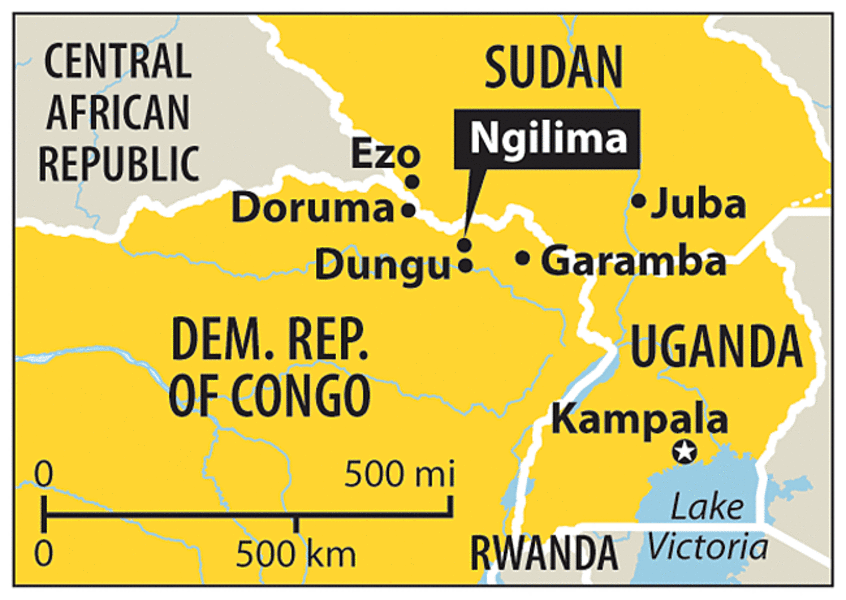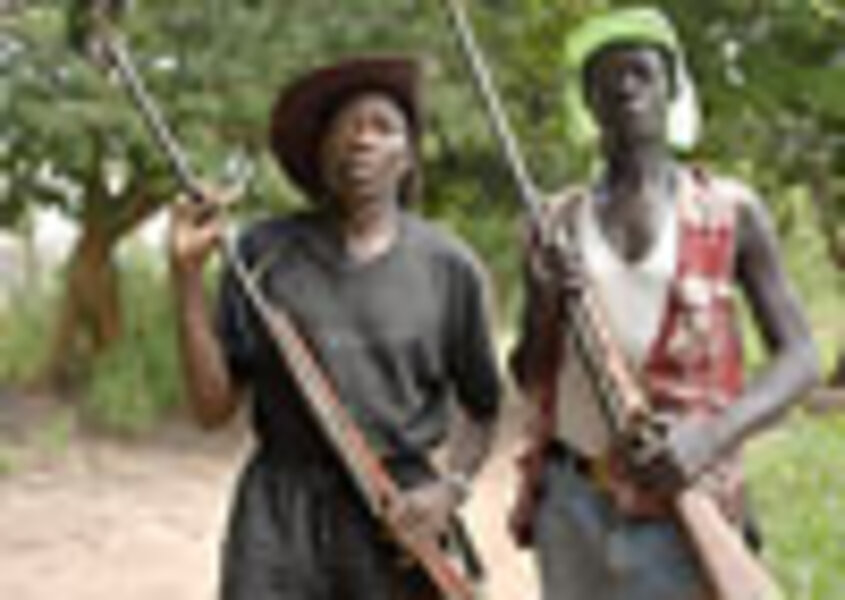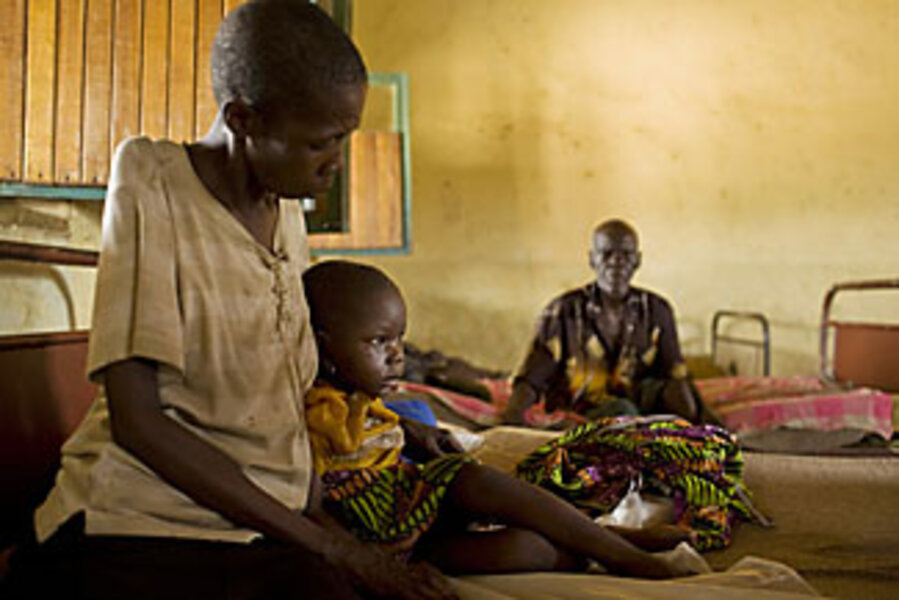Brutal retreat of LRA rebels in Congo
| Ngilima, Democratic Republic of Congo
Nelson Ngamu is so weak that he can barely stand up.
Up until he was captured by Congolese troops three days earlier, Mr. Ngamu was a foot soldier in one of Africa's most brutal rebel groups, the Lord's Resistance Army (LRA). He was abducted from his village in South Sudan at age 12. After watching LRA rebels kill his family, over the next 11 years, he was transformed from a prepubescent farmer's son into a confessed murderer.
Now, nearly two months after a US-backed military mission to finish off the LRA, Sudanese, Congolese, and Ugandan commanders of the joint operation say the rebels are slowly starving to death, losing contact with their leadership, and running out of ammunition. But fresh details from soldiers involved in the operation, former LRA abductees, and local villagers reveal that success is coming at a heavy price.
Since a Dec. 14 Ugandan airstrike on LRA bases in northeastern Congo, Ngamu and hundreds of other fighters from the LRA have butchered, bludgeoned, and burned their way across an area the size of Belgium. More than 900 people are estimated to have been killed, most of them hacked to death with machetes or beaten by clubs. Hundreds of children have been abducted and 133,000 people have fled their homes, the UN says.
The push against the rebels has been "catastrophic" for civilians, UN humanitarian chief John Holmes said Tuesday after visiting one of the areas hit hardest by fighting.
Stay the course?
Still, Mr. Holmes said the operation must continue and the commanders of the operation remain bullish about the prospects for success.
Almost 50 fighters have been captured and more than 150 killed, says Capt. Deo Akiiki, a spokesman for the Ugandan Army. Estimates for the number of remaining combatants range from 400 to 1,500.
There are 4,000 Congolese troops, from the most professional brigades in a notoriously unreliable army, and an estimated 2,000 Ugandan soldiers on the ground. Already, they are setting the timeframe for finishing off the LRA in terms of weeks rather than months.
But it is difficult to share their sense of optimism. Countless previous predictions of the LRA's imminent demise have proved unfounded.
Over the past two decades, Joseph Kony's army has survived concerted military onslaughts against its bases in Northern Uganda and South Sudan.
Who is the LRA?
Originally from across the border in northern Uganda, for the past 22 years the LRA has carried out an odyssey of terror across four countries in this remote region. Commanded by a self-proclaimed spirit medium and prophet, Mr. Kony, their attacks combine satellite telephones, night-vision goggles and established guerrilla tactics with witch doctors' fetishes and the deadly fanaticism of Mr. Kony's skewed mysticism.
Aligned against them is a coalition of Congolese, Ugandan and South Sudanese armed forces that have come together in a rare act of unity designed to eradicate the LRA once and for all.
The operation, codenamed Lightning Thunder, was launched after Kony failed to show up to sign a comprehensive peace agreement with the Ugandan government in late November.
It was the 13th time in two years that Kony had stayed home. A key sticking point was the fate of an arrest warrant issued by the International Criminal Court against Kony and two of his surviving lieutenants. Reports in the US-media suggest that President Bush gave his personal go-ahead for American officials to help with planning, intelligence and fuel for the operation to capture or kill Kony.
A difficult mission
This time, due to a combination of ill-planning and poor coordination between the various forces involved, the operation got off to wobbly start.
First, bad weather prevented the Ugandans from sending in their aging MIG-21 fighter jets to attack the LRA camps.
Instead, after a delay of four hours, cumbersome attack helicopters were dispatched, the noise of their engines giving the LRA vital time to flee.
It then took another two days for the first ground troops to arrive.
Given the LRA's track record of violent retribution against innocent civilians, the bloody and coordinated attacks that followed were devastatingly predictable.
LRA killing as they flee villages
Justin-Yves Rabbi was working in the fields outside the LRA camp the morning the Ugandan missiles hit. Ten months earlier, Rabbi and his two sisters were abducted from their home in Central African Republic hundreds of kilometres to the north.
A trained nurse, Rabbi's ability to save LRA lives meant that his was spared and he was put to work as an assistant to Kony's personal doctor.
His younger sister, aged 17, was taken by Kony as one of his 50 wives.
A month before the attacks, she gave birth to a son.
Vitally, Rabbi said, the first wave of attacks failed to capture or kill Kony.
Although the aerial bombardment came as a surprise, the bombs fell off target and very few fighters were injured. After the bombardment, the LRA had ample time to regroup and split up. Rabbi was among a group of 80 abductees and 150 fighters that headed south-west under the command of a senior LRA leader.
The commanders remained in contact with Kony via satellite phones.
What happened next was carefully directed by the LRA leadership.
"It was then that the order came to start killing everyone. After the attacks, they declared total war against the population," Rabbi said.
As they headed off into the bush, the group of fighters Rabbi was with would splinter to attack villages along its path.
Machetes and clubs were used to save on the dwindling supplies of ammunition.
Over Christmas, hundreds of people were massacred as they gathered to celebrate. In at least two villages, churches were set alight with scores of people still inside. After another month of wandering, Rabbi managed to escape when the group he was with broke up after encountering a Congolese army patrol.
How to protect civilians
Whatever the success or otherwise of the joint military operation, the protection of civilians in the region appears to have been only a distant afterthought.
Although the Congolese Army is now deployed in many of the hotspots, they arrived only in time to bury the victims of the first wave of LRA attacks. Six weeks on, if there is a frontline in the LRA's war against the people of north-east Congo, then the town of Ngilima is on it.
Over the past few weeks, a local health worker says the town's population has swelled from 11,000 to around 30,000 as people have flooded in from villages being attacked nearby.
The Congolese Army is stationed in the town and is conducting operations against a suspected group of fighters to the north. One needs an Army escort of eight heavily armed soldiers to travel the 45 kilometers along a mud track from the main army base to the town. Beyond Ngilima there is just bush and fear.
As she is brought into town on the back of an army motorbike, the fresh machete wound above Charlotte Lipayi's right elbow marks her as one of the most recent victims of the LRA's attacks.
The night before, she had left the relative safety of Ngilima to return to her village 25 kilometers away to forage for food for her family. At 9 a.m. she was on the road back. That was when six heavily armed LRA fighters found her.As she fled, a fighter hacked at her arm. A 22-year-old woman she was with was caught and violently raped, she says. Remarkably though, both survived.
Their lives were spared, she says, so that they could go back to their villages to warn the people and Army troops there that the LRA was still around and still able to attack.
The swirl of terror that the LRA systematically leaves in its wake is fueling a mounting humanitarian crisis. Swathes of territory are cut off by a deadly combination of insecurity and inaccessibility.
The handful of nongovernmental organizations still working in the region make only infrequent and highly risky airplane journeys to the various bush outposts.
In the few islands of relative security like Ngilima, food supplies for the displaced people are running precariously low.
It is harvest time but people are trapped in the towns, too scared to go to their fields. In the health centers around the region, medicines are running out.
Where's the UN?
The $1 billion-a-year UN mission to Congo, MONUC, does have a base nearby. Around 400 Moroccan troops and 50 Indonesian engineers are stationed in a heavily guarded camp by the airstrip outside Dungu, the largest town in the area.
Their main job, it seems is to provide logistical air support for the operations of the Congolese army.
Apart from that, MONUC appears to be too understaffed to be effective in this part of Congo.
Doctors Without Borders, one of the few NGOs still working in the area, has officially attacked the UN mission for not doing enough to defend the population, an accusation that MONUC denies. The feeling of betrayal among locals is undeniable, however. Many say that if the UN is not fighting against the LRA, they must be helping them.
Rumors of complicity are rife and MONUC's previous base in the center of Dungu was attacked by thousands of angry inhabitants after the UN troops failed to respond during a previous raid by the LRA in early November. On that occasion, UN staff had to be rescued by the Congolese Army they are meant to be supporting.
Just over 15 kilometers from the UN base, 13 men in the village of Kakado have taken matters into their own hands in a bid to protect their families and the population of more than 1,000. As he lowers the dirty length of rope that serves as an improvised road-block, Jean-Pierre Namuchamo introduces the self-defense unit he heads.
Most carry little more than a slingshot, bow and arrow, or spear. At best, they can muster a home-made rifle, built to hunt monkeys and stuffed with used shotgun cartridges filled with ball bearings. In other villages around the region, similar self-defense groups have sprung up.
Crouching in the bushes by the side of the road, Mr. Namuchamo shows how he hides his men at night. If the LRA attacks however, he admits that his group could not put up much resistance. "But we are tired of running away," he explains. "If no one else will defend us, we decided that we would have to do it ourselves."








